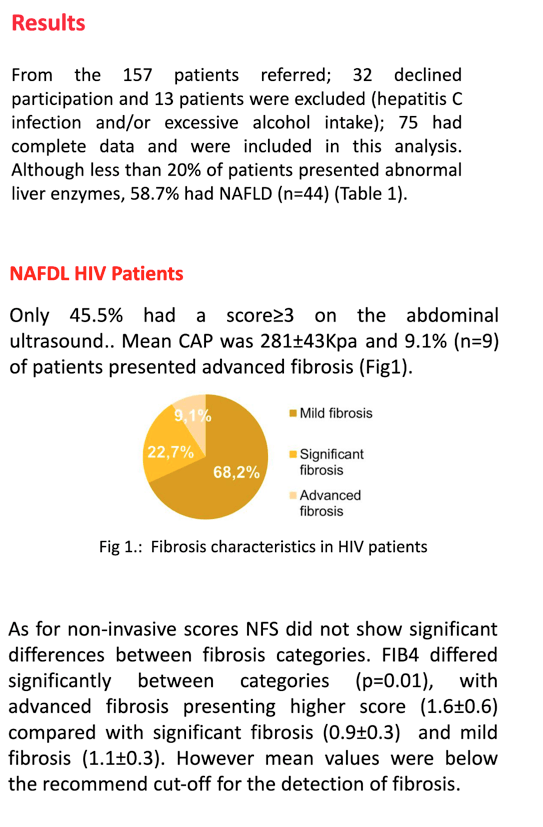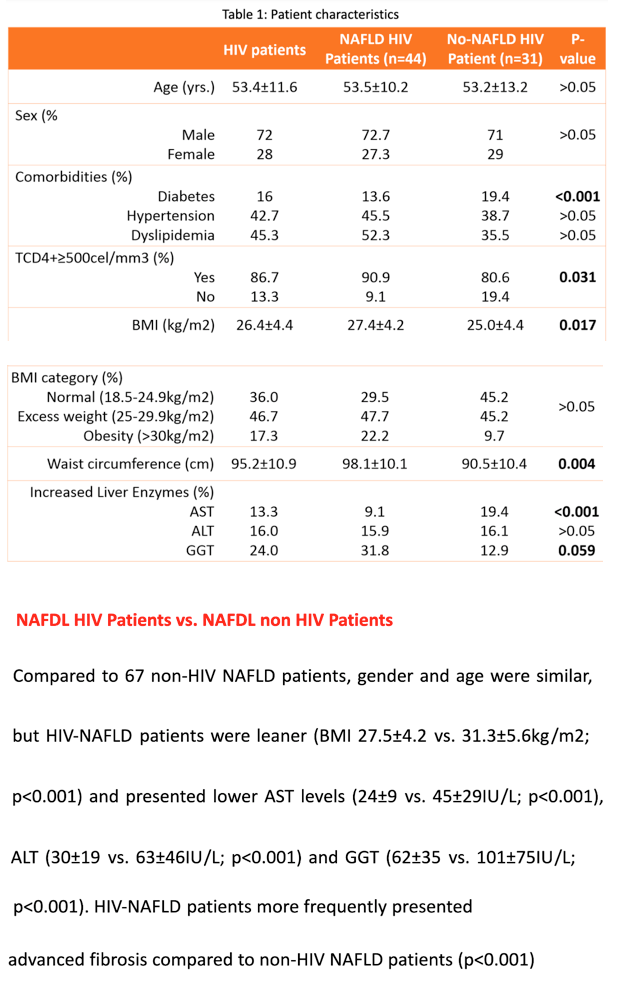 |
 |
 |
| |
Is NAFLD the same disease in HIV infected patients?
|
| |
| |
Sara Policarpo, Faculdade de Medicina Universidade de Lisboa

BACKGROUND: Non-Alcoholic Fatty Liver Disease (NAFLD) is a growing comorbidity in HIV-infected population, in association with the obesity pandemic. We aimed to determine the prevalence and epidemiology of NAFLD in HIV patients and to compare it with non-infected NAFLD patients.
METHODS: HIV patients without known liver disease followed at an Infectious Disease outpatient clinic in a tertiary university hospital were included. Clinical and anthropometric data were collected. Patients with opportunistic diseases, hospital admission in the previous 3 months and on hepatotoxic drugs were excluded. HIV patients were screened for NAFLD and HIV-NAFLD patients were compared with non-HIV NAFLD patients from the Hepatology Outpatient Clinic.
RESULTS: 157 patients were referred; 32 declined participation and 13 patients were excluded due to identification of hepatitis C infection and/or excessive alcohol intake; 83 patients were included in this analysis, mostly Caucasian (72%;n=60), males (65%;n=54), with mean age 53±12years (24-90years), TCD4+ >500cel/mm3 (78%;n=65), all with undetectable viral load. 68 patients had BMI >25kg/m2. Less than 20% of patients presented abnormal liver enzymes, but 53% had NAFLD (n=44). The prevalence of abnormal aminotransferases was similar in HIV patients regardless of the presence of NAFLD. Using a fibroscan device, mean controlled attenuation parameter (CAP) was 282±44; Elastography showed F2-F3 fibrosis in 23% (n=10) and F4 in 9%(n=4). FIB4 could not predict liver cirrhosis and elastography did not correlate with steatosis severity. HIV-NAFLD presented higher BMI vs. HIV non-NAFLD (27.5±4.2 vs. 25.1±4.4kg/m2;p=0.031). Compared to 67 non-HIV NAFLD patients, gender and age were similar, but HIV-NAFLD patients were leaner (BMI 27.5±4.2 vs. 31.3±5.6kg/m2;p<0.001) and presented lower AST levels (24±9 vs. 45±29IU/L;p<0.001), ALT (30±19 vs. 63±46IU/L;p<0.001) and GGT (62±35 vs. 10175IU/L;p<0.001). HIV-NAFLD patients more frequently presented advanced fibrosis compared to non-HIV NAFLD patients (32 vs. 9%;p<0.001).
CONCLUSIONS: The preliminary results of this ongoing study suggest that NAFLD is highly frequent in compensated HIV patients, and present more frequently with advanced fibrosis as compared to non-HIV NAFLD patients, despite lower BMI and lower liver enzymes. In fact, non-invasive scores did not seem to accurately discriminate advanced fibrosis in HIV-NAFLD patients.




|
| |
|
 |
 |
|
|